“I am attempting to communicate,” astronaut Roy McBride offers into a microphone, his voice translated into a signal to be broadcast via laser signal out to Neptune, where his long-absent father is lurking in the darkness.
Although the film is nominally set in the “near future”, director James Gray pitches Ad Astra as a nostalgia piece. It is Heart of Darkness (really Apocalypse Now) by way of 2001: A Space Odyssey, but it also has faint shades of Star Wars in its portrayal of a father-son schism elevated to cosmic drama. Ad Astra presents the universe as a stark-yet-beautiful place, and the film itself fits that aesthetic. Cinematographer Hoyte van Hoytema has experience making space look stunning from Interstellar, and that carries over to the rich-yet-sterile look of Ad Astra.

Spaced out.
There are times when Ad Astra feels a little too arch and a little too dry in its meditative space odyssey. Roy’s constant internal monologue walks a fine line between profundity and self-parody. The film locks itself so firmly to Roy’s perspective, and nestles itself so snugly inside his head, that the world around him occasionally feels illusory. Of course, all of this is intentional. Gray clearly intends to contrast Ad Astra with the obvious epic space adventures to which it is indebted, and his stylistic sensibility certainly allows it to stand apart.
Ad Astra is a vivid story of extraterrestrial alienation, just one that doesn’t happen to feature any aliens.

Shock and launch.
The plot of Ad Astra is largely inessential. Decades earlier, pioneer Clifford McBride disappeared on a mission to look for extraterrestrial life at the edge of the solar system. The LIMA project went where no man had gone before, and it did not come back. When Earth finds itself targeted by electronic signals broadcast from Neptune, military officials turn to Clifford’s estranged son. Roy became an astronaut like his father, although his argument that he did it for the betterment of mankind “and all that” is not uttered with conviction.
Gray distinguishes Ad Astra from superficially similar space operas by largely eschewing exposition. Ad Astra is a film with seemingly massive stakes – at one point, a monitor puts the death toll from the electronic pulse around 12,000 – but the film is consistently detached from that. There are no scenes of characters drawing diagrams. There are only a handful of computer-modelled mission briefing shots, and only glimpsed fleetingly. The particulars of various infrastructure or technology are left vague. Even 2001 featured a longer and more detailed briefing sequence.

“Brad Astra.”
All of this is intentional. Characters in Ad Astra repeatedly draw attention to Roy McBride’s steady heartbeat. He repeatedly confirms reports that his heartbeat remains constant at eighty beats, no matter how dangerous or how absurd the situation; the film’s opening sequence features an impromptu skydive, and even that fails to get Roy’s pulse racing. Even when he is on Earth, Roy is detached and apart. His heart may be steady, but it is cold. The film devotes as much time to the clinical acknowledgement of Roy’s break-up with his lover Eve as does to thousands of deaths.
This is true even on a smaller and intimate scale. Gray has assembled an impressive cast, including actors like Ruth Negga and Donald Sutherland. However, these characters drift into and out of narrative focus as easily as they enter and leave Roy’s orbit. At one point in Ad Astra, Roy decides to go on without a previously reliable travelling companion. He leaves his friend in a precarious situation, trapped between life and death. The film offers the audience no firm indication of how that situation resolves. Roy never finds out how it plays out, so the audience remains in the dark.

“Dad Astra.”
The coldness of Ad Astra places the audience inside Roy’s perspective. Gray invites the viewer to process this spectacle through a man who is numb to it all. It’s a daring and fascinating approach, to the point that Gray makes even Kubrick’s clinical 2001 seem like a film of boundless exhilaration and enthusiasm. To be clear, Ad Astra captures the majesty and wonder of space – the impossible scale of it, the incredible beauty of it, the uncanny awe of it. However, they also capture the coldness of it. Ad Astra is not just a film about space, it’s a film about leaving Earth.
This can occasionally be frustrating, particularly in the early stretches of the film where Gray is adhering most rigidly to the structure of these sorts of films and when the audience most desperately needs a hook into the story. Ad Astra is such a wry film that its best joke is the casting of Liv Tyler as Eve, effectively reprising the role that made her a star with Armageddon over two decades earlier. Even then, the film doesn’t crack a smile. It trusts the audience the note that context as Roy ruminates on the callouses that are forming over his own heart.
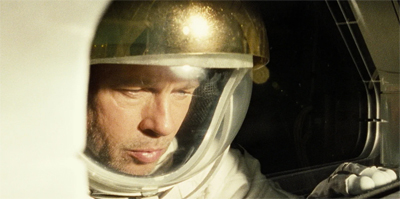
“Sad Astra.”
Once the film finds its groove, this becomes a strength. In its own way, Ad Astra feels as much a period piece as some of Gray’s earlier films like The Immigrant or The Lost City of Z. The film offers a throwback to the daring space adventures of the fifties and sixties, tales of astronauts who journeyed to strange new worlds in the hope of expanding humanity’s understanding of the wider cosmos. Roy’s journey to the outer reaches of the solar system take him from the lunar surface to Mars and then on past Jupiter.
The film looks beautiful, capturing the wonder of those gigantic extraterrestrial objects. Gray provides a tense chase sequence on the surface of the moon, and politicking inside the base on Mars. Ad Astra is often shots in shades of primary colours like red and blue, never downplaying the alienness of the spaces in which Roy finds himself. There is a sense that Roy McBride’s cosmic adventures could make for a satisfying dime store paper back or trashy B-movie. However, that is not how Gray chooses to approach the material.
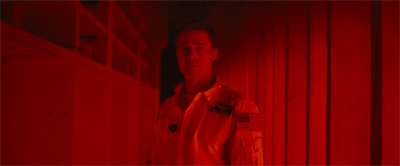
“Rad Astra?”
Melancholia permeates Ad Astra, a funereal tone informing and shaping all of its pulpy plot elements. As much as Ad Astra is indebted to 2001, right down to specific shots and set pieces, Gray understands that the future of 2001 is long lost. Roy McBride is journeying through a vision of the future that has been lost to time. This reality shapes and distorts Ad Astra, explaining where Gray chooses to place his emphasis within a familiar template.
The introspective Roy McBride owes much more to Ryan Stone from Gravity or Joseph Cooper from Interstellar or even the version of Neil Armstrong presented in First Man than he does to David Bowman from 2001 or the ensemble in The Right Stuff or even the real-life astronauts captured in Apollo 11. As such, Ad Astra eschews the romantic ideal of space travel as a force that might unify the entire human race, and instead filters it through the lens of personal experience.
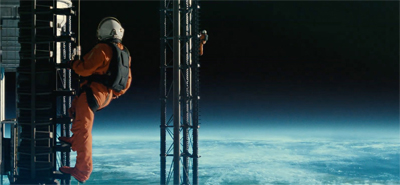
A towering accomplishment?
As much as the basic narrative of Ad Astra might evoke the sixties or the seventies, the film itself arrives fifty years later. The world has changed. 2001 was emblematic of science-fiction leading up to the moon landing. The genre had long been preoccupied with idea of space flight and alien contact. Think of the enthusiasm of Kirk’s “five-year mission” of exploration in Star Trek or classics like Forbidden Planet. Writers like Michael Benson argue that science-fiction helped to fuel public appetite to put a man on the moon.
At the same time, it has also been argued that the moon landing led to the decline of that sort of science-fiction. The argument goes that the public became disillusioned with space flight once it became clear that there was very little of immediate interest out there and more ambitious missions were not viable in the short term. Audiences were confronted with the realisation that space was hostile, quiet and mostly empty. Certainly, public and financial support for NASA fell sharply in the years that followed.
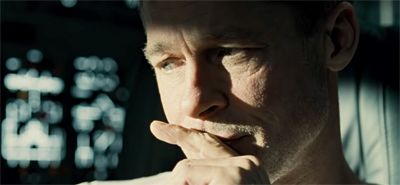
All Cooped up.
After the moon landing, a lot of high-profile science-fiction shifted away from space exploration. Films like Logan’s Run or The Omega Man focused on more Earth-bound nightmares. When space travel did appear, it became a lot grubbier and grittier in films like Alien or Outland. On Star Trek: The Next Generation, Picard spent more time as a diplomat than an explorer. Even the alien-filled universe of Star Wars arguably owes as much to fantasy as it does to science-fiction.
Of course, the past decade has seen a renewed interest in space flight. While governments like India and China are pushing their space flight programmes and while “space force” promises to militarise outer space, the push to Mars and beyond is largely driven by private enterprise rather than patriotic or humanist aspiration. During the nineties, organisations like SETI attracted attention by searching for alien life, but they have faded slowly into the background.
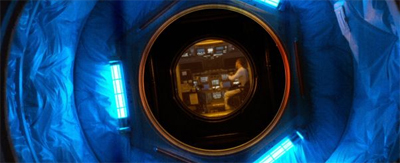
The gravity of the situation.
Ad Astra essential filters those fifties and sixties pulp science-fiction narratives through the lens of that modern disillusionment. While 2001 celebrated the very idea of contact between humans and extraterrestrials, Ad Astra suggests that Clifford McBride’s pursuit of “intelligent life” is nothing short of madness. Modern space narratives tend to emphasise how alone mankind truly is in the cosmos. The outside forces at work in Interstellar are ultimately just representatives of mankind’s future potential, rather than any truly alien intelligence.
With that optimism and enthusiasm erased, with a grim acknowledgement that there is likely nothing of value waiting for mankind out there in the cosmic void, these space narratives have become increasingly introspective. Stories like Gravity and First Man are largely about the idea that there is nothing in the void beyond what these explorers bring with them. Roy’s journey to Neptune is not important because of the LIMA project or because of any galactic stakes. It is important because it allows Roy to confront his own demons and his own ghosts.
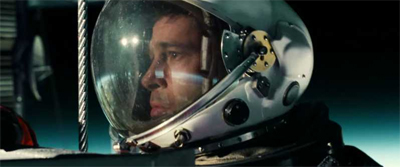
… Ad Visor?
There is something beautiful and lyrical in that, in the way that Gray takes a very modern perspective on mankind’s place in the larger universe and then works it through the trappings of a nostalgic template. This is why Heart of Darkness works so well as a basic story structure, along with the archetypal Campbellian rhythms of a son confronting his father. These provide a framework even older than pulpy space adventures, suggesting that these sorts of stories predate fantasies of lunar exploration or deep space voyages.
Roy’s story is a modern angle on an established template, but it’s also something much older. This gives Ad Astra a unique angle on a familiar story, allowing the film to serve as something of an unlikely bridge between the past and the present of science-fiction. Ad Astra works because it commits so thoroughly to both approaches. Its cast are more than capable of doing the dramatic lifting required of them, with Pitt holding focus for the entirety of the movie’s runtime. However, the production design and special effects provide some of the most striking visuals of the year.
Ad Astra is a story about there’s nothing in space but what people bring with them. And hopefully, what they leave behind.
Filed under: Non-Review Reviews | Tagged: 2001: A Space Odyssey, ad astra, brad pitt, film, Movie, non-review review, review |




















Leave a comment